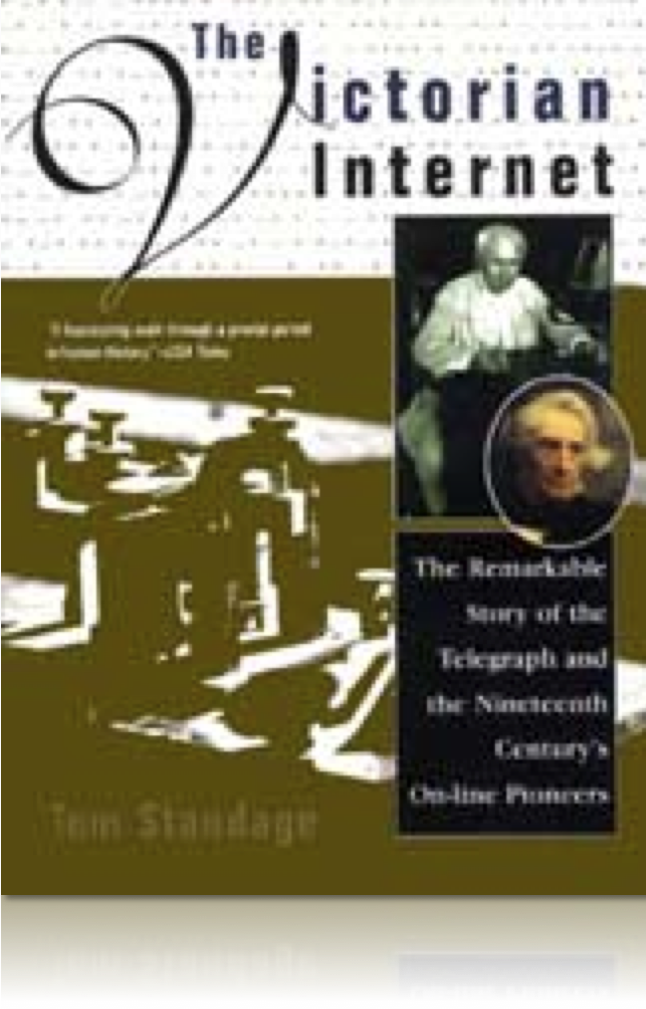Review: The Victorian Internet by Tom Standage
Long before the Web, there was a network of wires that connected continents, carried communications, and changed the way societies did business. The Victorian Internet is a fascinating look at the origins, development, and impact of the telegraph, a technology as revolutionary for its era as the Internet has been for ours.
Standage begins by setting the stage for understanding the limits of long-distance communication before this invention. Messages had to be carried from one place to another; victories in battles and entire wars hinged on the delivery (or loss) of a message. Signalling, usually military in purpose, was the first step in “distance writing,” or telegraphy.
Flags, lanterns, and flashes of sunlight were used to send messages faster than a horse or a man could run to the distant receiver. High places were pressed into use as signal towers for these line-of-sight “networks”—the Col du Telegraphe featured in some years as a hill-climbing stage in the Tour de France bicycle race is named for one of these signalling stations. Use of the Col du Telegraphe as a line-of-sight sending point continues to this day; a huge radio/TV tower complex can be seen behind the race-day crowds at the summit.
While faster than a messenger on foot or horseback, visual signalling with an optical telegraph had several drawbacks. Weather, sunlight levels, and even the stirring of air between sender and receiver could distort the message or prevent it being sent. Because of this and other limitations, codes were used to shorten the “bytes” of information that needed to be sent, and these were often full codes. The sender would encode “23,” for example, and the receiver would need to look up this number in his book to discover that “Reply Urgently” was the message.
Another drawback was the “public” nature of the signal. Anyone positioned to see the originating station could receive the signal. All they needed was a copy of the code book to be privy to any message sent. Telegraphers responded by using more sophisticated codes, but in order to be useful, any code needed to be known by at least two people, the sender and the intended receiver. These “secret” codes thus became a target for espionage.
Finally, an optical telegraph network was incredibly expensive to build, maintain, and man. Once governments had created such expensive systems, they had a vested interest in maintaining them, even when the first electrical telegraphs were proposed. But progress was coming, inevitably.
Samuel B. Morse was born in Massachusetts in the same year the optical telegraph was demonstrated by Chappe in Britain. By the mid-1830s, Morse, an Englishman named William Fotheringill Cooke, and a Russian diplomat, Baron Pavel Lvovitch Schilling, were all working on building an electrical telegraph.
Standage fills the book with tidbits that help to make the connection between the electric telegraph and the Internet. There are duels between different platforms, standards, and codes; the galvanic receiver used by Schilling and Cooke is superseded by the clicking electromagnet proposed (but never tested) by British physicist Peter Barlow in 1824.
 |
| Telegraph message delivered in 1959. |
New users are amusingly clueless; people expect objects to be shipped by telegraph (because a messenger could deliver not just a love note, but also a bouquet of flowers.) “Hackers” leverage their greater understanding of the new technology; they use the swift messaging to influence stock prices and get insider information that helps them win bets. There are even “bloggers,” usually telegraph operators, who use down-time on the system to play chess, send greetings, and trade jokes with operators further down the line.
In a chapter titled “Information Overload,” Standage looks at an issue that is still of concern. The radical effects of speedier communication were felt first in business, which had been an early adopter: “Any business that wanted to stay competitive had no choice but to embrace the new technology. The result was an irreversible acceleration in the pace of business life, which has continued to this day.” This pace accelerated further with the invention of the stock ticker, a special-purpose telegraph of which it was written, “The letters and figures used in the language of the tape are very few, but they spell ruin in ninety-nine million ways.”
The genius of Thomas Edison, the quintessential American inventor, was in a way a by-product of the telegraph system. Edison earned early fame as a star Morse-code reader (which may have been because his partial deafness made it easy for him to ignore other auditory distractions), and fed his genius mind with experimentation in various telegraph offices. At 21, he went to New York and, unable to afford a hotel, slept on the floor of the Laws Gold Indicator Company. Edison soon figured out how the Indicator, an early stock-ticker, worked. He invented a better version, sold it to the company, and was hired as an “in-house R&D” department.
Ironically, it was improvements devised by Edison and a multitude of others that would eventually lead to the demise of the telegraph, along with the community that had grown up around it. Any industry founded on one specific technology faces the danger that a new invention will render it obsolete.
Standage declines to speculate what invention might replace the Internet. But he does conclude, with the wisdom of hindsight, that our own awe at the far-reaching changes made by the Web in our society is provincial and nearsighted.
If any generation has the right to claim that it bore the full, bewildering, world-shrinking brunt of [a communications] revolution, it is not us—it is our nineteenth-century forebears.

No comments:
Post a Comment